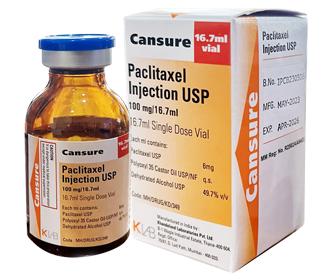
CANSURE 100 Inj
Therapeutic Class
Chemotherapeutic Drugs
Indications
CANSURE (Paclitaxel) is indicated for the treatment of metastatic carcinoma of the ovary or breast after failure of standard therapy The standard therapy means an anthracycline containing regimen for ovarian cancer unless clinically contraindicated.
Chemical Composition
Each ml contains Paclitaxel USP 6 mg
Packaging
16.7ml vial /Box
Dosage & Administration
All patients should be premedicated prior to CANSURE administration in order to minimize severe hypersensitivity reactions. Such premedication may consist of dexamethasone 20 mg orally approximately 12 and 6 hours before CANSURE, diphenhydramine(or its equivalent) 50mg IV 30 to 60 minutes prior to CANSURE and cimetidine(300 mg) or ranitidine(50mg) IV 30 to 60 minutes before CANSURE. CANSURE at a dose of 175 mg/m2 administered intravenously over 3 hours every three weeks has been shown to be effective in patients with metastatic carcinoma of the ovary or breast who have failed standard therapy. Single courses of CANSURE should not be repeated until the neutrophil count is at least 1,500 cells/mm3 and the platelet count is at least 100,000 cells/mm3. Patients who experience severe neutropenia (neutrophil <500 cells/mm3) or severe peripheral neuropathy during CANSURE therapy should have the dosage reduced by 20% for subsequent courses of CANSURE.
Contraindications
The drug is contraindicated in the following patients. Paclitaxel is contraindicated in patients who have a history of severe hypersensitivity reactions to Paclitaxel or other drugs formulated in Cremophor+EL (Polyethoxylated castor oil). Paclitaxel should not be used in patients with severe baseline neutropenia (<1,500 cells/mm3).
Side Effects
The incidence of adverse reactions that follows are derived from ten clinical trials in carcinoma of the ovary and of the breast involving 812 patients treated at doses ranging from 135-300mg/m2/day and schedules of 3 to 24 hours. Summary of 3 hour infusion data at dose of 175 mg/m2 Unless otherwise stated, the following safety data relate to 62 patients with ovarian cancer and 119 patients with breast cancer treated at a dose of 175 mg/m2 and a 3 hour infusion schedule, in Phase Ill Clinical trials. All Patients were premedicated to minimize hypersensitivity reactions. Data from these clinical trials demonstrates the Paclitaxel given at this dose and schedule is well tolerated. Myelosuppression, in particular, is less frequent and incidence of hypersensitivity reaction, peripheral neuropathy or other significant undesirable effects was not. None of the observed toxicities were influenced by age. Hematologic The most frequent significant undesirable effect of Paclitaxel was bone marrow suppression. Severe neutropenia (<500 cells/mm3) occurred in 27% of pateints, but was not associated with febrile episodes. Only 1% of patients experienced severe neutropenia for 7 days or more. Eighteen percent of patient had an infectious episode. Although severe septic episodes associated with severe neutropenia attribute to Paclitaxel were reported in early clinical trials, no severe infections or septic episodes were seen at the recommended dose and infusion schedule. Thrombocytopenia was reported in 6% of patients. One percent of patient had a platelet nadir count 50,000/mm' at least once while on study. Anemia was observed in 62% of patients, but was severe (Hb<8 g/dL) in only 6% of patients. Incidence and severity of anemia are related to baseline hemoglobin status. Hypersensitivity Reactions A Significant Hypersensitivity reaction ( defined as hypotension requiring therapy, angioedema, respiratory distress requiring bronchodilator therapy, or generalized urticaria) occurred in 2 patients. Thirty-nine percent of patients (20% of all courses) experienced minor hypersensitivity reaction, These minor reaction, mainly flushing and rash, did not require therapeutic intervention nor did they prevent continuation of Paclitaxel therapy. Cardiovascular Hypotention and bradycardia have been observed during administration of Paclitaxel, but generally do not require treatment. Frequent vital sign monitoring particularly during the first hour of Pacitaxel infusion, is recommended. Continuous cardiac monitoring is not required except for patients who develop serious conduction abnormalities. Nervous System Although the occurrence of peripheral neuropathy is frequent, the development of severe symptomatology is unusual and requires a dose reduction of 20% for all subsequent courses of Paclitaxel. Hepatic There is no evidence that the toxicity of Paclitaxel is enhanced in Patient with abnormal liver function, but no data are available for patients with severe baseline cholestasis.
Drug Interaction
In a Phase 1 trial using escalating doses of Paclitaxel (110-200mg/m2) and cisplatin (50 or 75mg/m2) given as sequential infusions, myelosuppresion was more profound when Paclitaxel was given after cisplatin than with the alternate sequence (i.e. Paclitaxel before cisplatin). Pharmacokinetic data from these patients demonstrated a decrease in paclitaxel clearance of approximately 33% when Paclitaxel was administered following cisplatin. Possible interaction of Paclitaxel with concomitantly administered medications have not been formally investigated.

